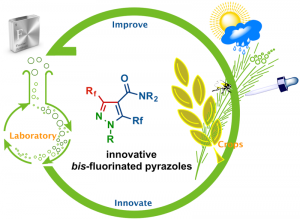Want create site? Find Free WordPress Themes and plugins.
The joint laboratory (LCR C2OF) between the CNRS, Bayer and the University of Strasbourg has been created in May 2014. It’s research focuses on organofluorine chemistry. In the current context of world population growth (estimated to reach 9 billions in 2050), the pressure on agricultural resources increases tremendously, and crop protection becomes a major challenge to ensure global food supply. The aim of LCR is to discover new molecules of interest, notably agrochemical and therapeutic, thanks to the introduction of emerging fluorinated groups in chemical compounds. The introduction of fluorinated groups in chemical compounds represents a major challenge for the discovery of new molecules of interest in Life Sciences.
Fluorine chemistry is a particularly important research area for the life and health sciences and is now booming: more than 50% of the active ingredients for plant protection currently under development contain this element. The field, which requires very specific know-how, is also subject to strong international competition. Being at the forefront of innovation is therefore of decisive importance for companies like Bayer. It is from this strategic will that the joint research laboratory for the chemistry of fluorinated organic compounds was created in 2014 resulting from a more global and long-standing collaboration between Bayer and the CNRS in various scientific fields.
In this laboratory, we are conducting research on the introduction of new fluorinated groups into bioactive compounds. They are developing new molecules including difluoromethyl (CHF2), difluoromethoxy (OCF2H) or trifluoromethoxy (OCF3) groups, alternatives to the widely used trifluoromethyl (CF3) group. These molecules represent “chemical bricks” for new fungicides, insecticides and herbicides, but also remain accessible to researchers in the Bayer Pharmaceuticals Division for application in therapeutic chemistry. The aim is to discover new active ingredients and develop new, more efficient and profitable synthesis routes for industrial-scale production, while minimizing the ecological footprint. Since the laboratory’s creation, this collaboration has been accompanied by numerous publications in scientific journals and patent applications.
Our research has already led to new processes, some of which are now used in industrial fungicide synthesis on a per-ton scale. For example, one of them was selected by industrial chemists to elegantly and efficiently introduce a difluoromethyl group (CHF2), highly prized in medicinal chemistry and agrochemistry.

Did you find apk for android? You can find new Free Android Games and apps.
